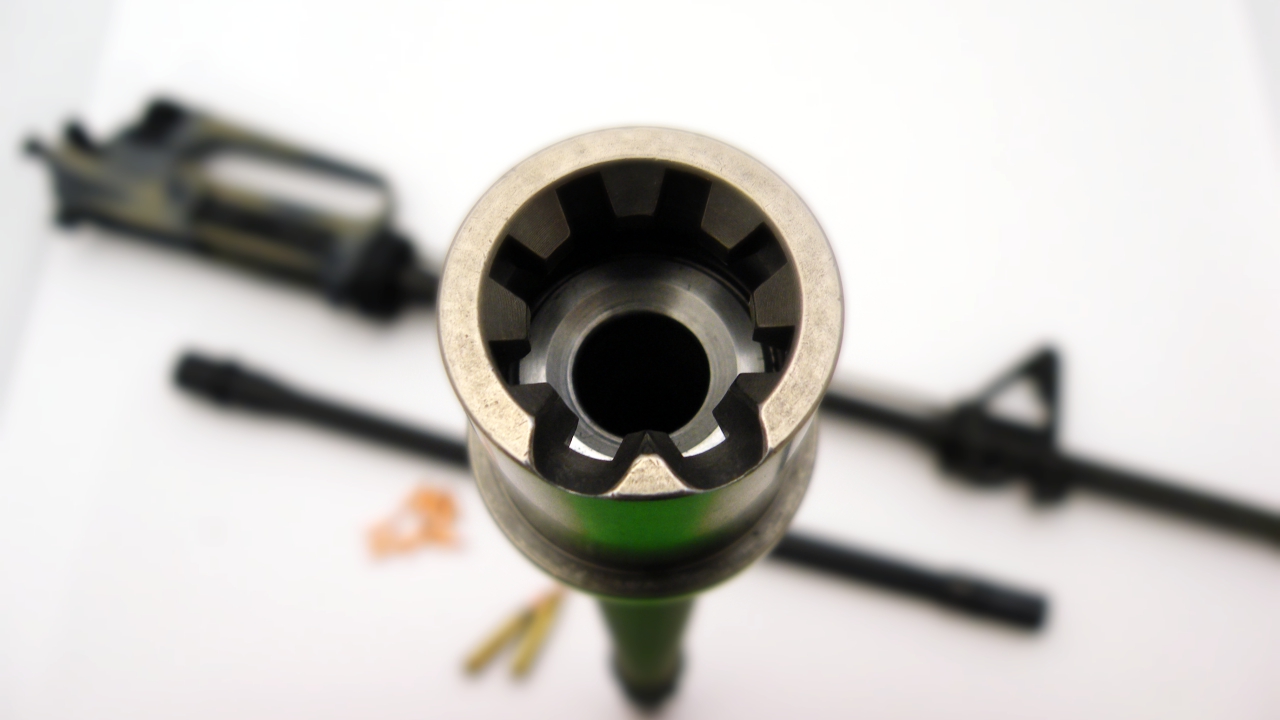I realize there are too many choices in the AR15 market. I see products and prices ranging from unknown brands on Midway USA at $120 all the way to eye watering $455 Noveske barrels. I read about match shooters calling their stainless steel barrel shot out by 3000 rounds while ADCO firearms runs a stainless steel barrel to 15k rounds and finds that it is still capable of minute-of-man accuracy. It can be confusing. I’m here to help. I’m not from the government. It’s time for a user guide. What type of barrel do you need for your AR15? How much money do you have to spend to get the accuracy you need?
Let’s break this guide down by barrel type: Chrome Lined Barrels, Stainless Steel Barrels, and QPQ / Melonited Barrels. Then we will examine the barrel profile, rifling, and other misc features.
How Much Do You Need to Spend?
Theoretically, we want a barrel that is accurate enough to meet our goals while maintaining longevity of barrel life for frequent practice with weight and secondary features as a consideration as well.
The truth is, most barrels, even entry-level barrels can outshout the novice shooter. If you have a particular shooting goal in mind, it is wise to find out what barrel will meet those goals and spend the right amount of money the first time so you can grow into the skill-set you wish to acquire. Buying a cheap barrel just to finish the gun can leave you unsatisfied if it cannot meet your goals as you gain experience. Let’s break down our primary barrel types: Chrome, Stainless, and Melonite barrels.
Chrome Lined Barrels:
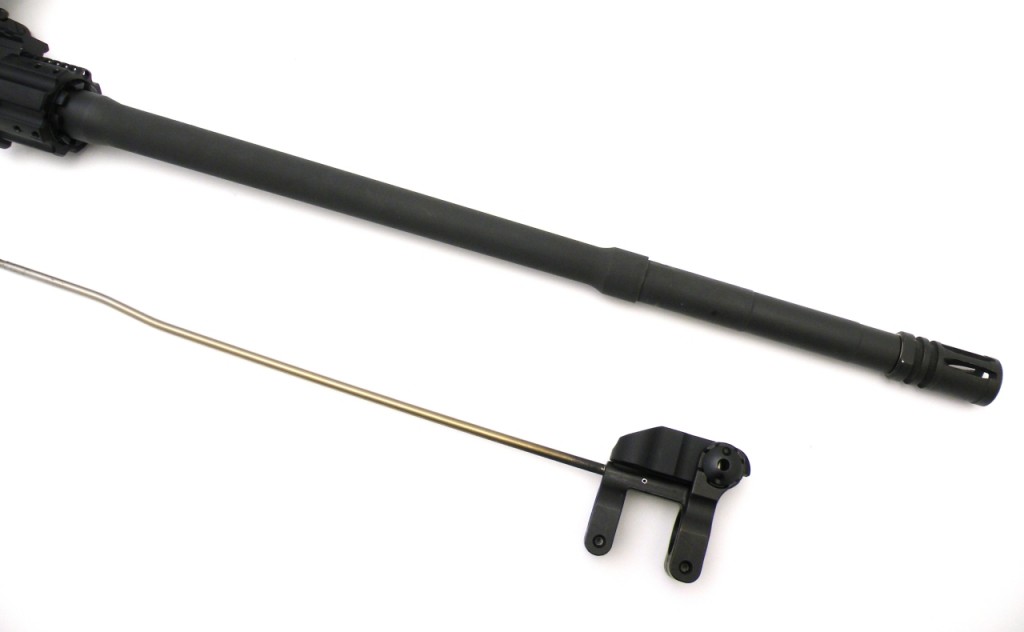
Criterion Barrels Inc. 18 inch parkerized, chrome lined, “hybrid” profile barrel. Some chrome lined barrels are capable of excellent accuracy, such as the above product.
For the most shooters, a quality chrome lined barrel will permit good use out to 600 yards and maintain acceptable accuracy to hit a man-sized target. I used a button rifled, chrome lined 4150, 1:7 twist FN barrel at a high power match and it took me to 600 yards without issue. The ubiquitous chrome lined AR15 barrel is typically capable of 1-1.5 MOA when free floated with match ammo. Chrome lining is the military specification for the M4 and M16 to increase barrel life, but this hardened bore causes a slight decrease in accuracy due to the inconsistencies it can apply over the rifling when it is applied.
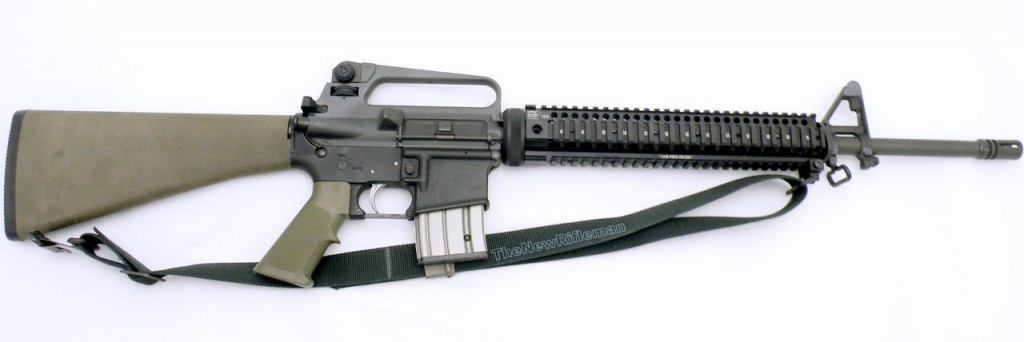
My FN Parts gun with a USGI button rifled, chrome lined barrel: chrome lined barrels have been the military standard for decades.
For the majority of us, chrome lined barrels will fulfill any possible SHTFantasy we could imagine while also remaining hard use for frequent practice. Prices range from $150-$280 for a chrome lined barrel. On the lower end of the scale we have barrels with 4140 steel, 5.56 or .223 Wylde chamber, a 1/9 twist, and button rifling: I consider the 1/9 twist, chrome lined barrel to be a shooter limiting product. The 1/9 twist is not capable of successfully stabilizing heavier ammo such as the 77 grain SMK. The chrome lining will further deteriorate longer range accuracy and with the inability to stabilize heavier loadings, may lead to a frustrating experience if you wanted to dabble in longer range shooting. Avoid.
Let’s move up to better barrel which is composed of a 4150 steel barrel, a 5.56 chamber (.223 wylde chamber is good too), with a 1/7 twist, chrome lined, button rifled. A barrel which meets those specs is a higher quality product than the cheap barrel assembly’s some manufacturers still ship with their rifles. The harder 4150 steel will resist erosion better after the chrome lining has burnt away from the throat. The 1/7 twist will stabilize any ammo you can conceivably shoot through the rifle. Touching base on button rifling: button rifled barrels have won matches for years; it is the care in which the manufacturer cuts and finishes the rifling which determines how accurate a barrel can be.
$ How much should I spend?
A quality chrome lined barrel will run anywhere from $180-$260 dollars. If you like the parkerized mil-spec look and want a hard use barrel with a moderate level of accuracy out of the AR15, don’t hesitate to go chrome. Keep it real, and do your research so you don’t get burnt. *Wanting the best of the best of the best most expensive ever* won’t make you a better shooter. Buying a quality product and spending the rest of the money on practice and ammo will make you a better shooter.
Going Stainless Steel: A Step Up in Accuracy
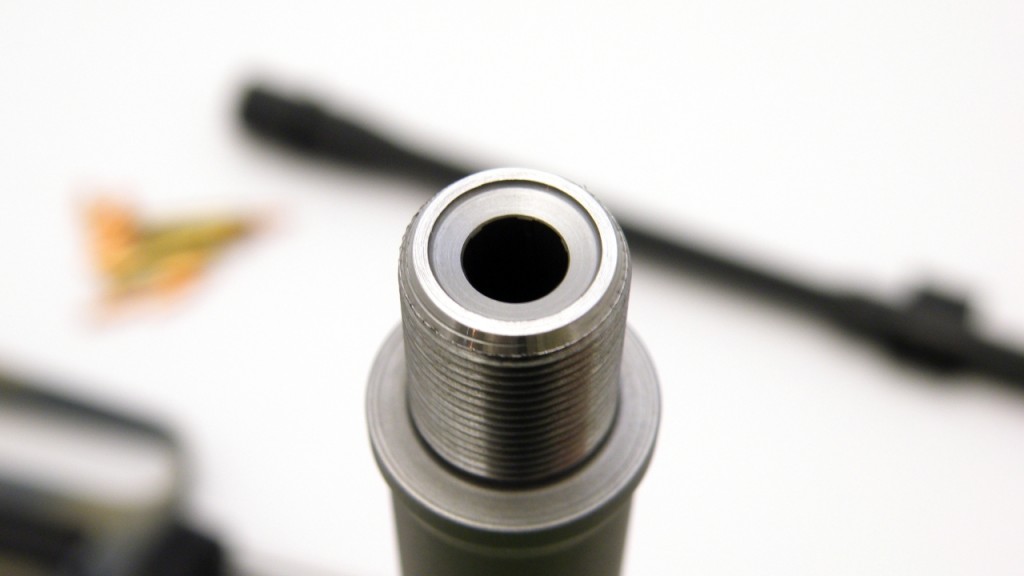
A Ballistic Advantage Stainless Steel Barrel with recessed target crown
Stainless Barrels have a reputation to those who value Precision. The properties of stainless steel make it easier for manufacturers to work with, and by skipping the chrome lining they are able to finish the bore and the rifling with a higher level of consistency. Stainless steel also offers some corrosion protection as well. When you want the highest in accuracy afforded by the AR15 platform, go stainless. What are the downsides?
You can’t abuse a stainless steel barrel and expect it to maintain the level of accuracy as when you first purchased it. Magazine dumps, cooking bacon on the barrel, and punishing the steel with frequent high volume shooting sessions will kill the accuracy of your SS barrel slightly faster than it will Chrome or Melonited barrels. Prolonged heat can erode the throat of the barrel and your accuracy will go south in a hurry. Throat erosion is what eventually kills accuracy. If you like shooting as fast as you can pull the trigger, go melonite or chrome.
Abuse would be defined as magazine after magazine as fast as you can pull the trigger. Using a SS barrel for 3 gun, double taps, and typical range use are not considered abuse of a SS barrel and it will give you a long service life with a high level of accuracy as your focus.
As it racks up thousands and thousands of rounds, your 0.5 MOA barrel may become a 1.5 MOA barrel which is still as accurate as a chrome lined barrel, so keep that in mind.
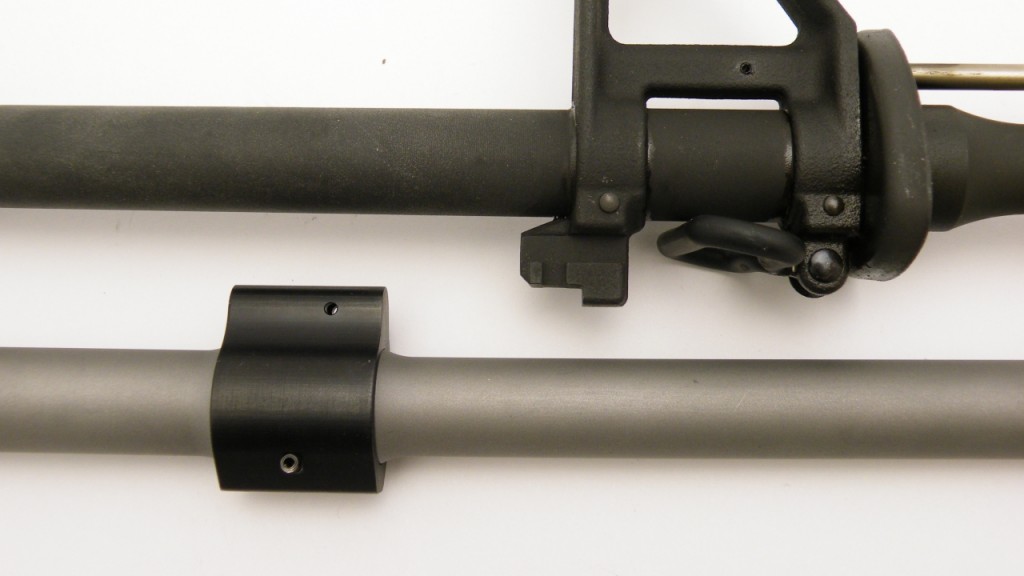
Stainless steel barrels can be bead blasted to remove the shine and impart a flat texture. Above from top Windham Weaponry 20 inch Gov’t 1/7 twist chrome lined; Ballistic Advantage stainless steel 1/8 twist Hanson profile
So what should you look for? A 1/7 or 1/8 twist, a .223 Wylde chamber, made of 416R steel in medium or heavy contour. This combination will net you a barrel that can stabilize anything that will fit into the AR, with a blend of SS that will have a great service life for a steel barrel, and in a contour that will soak up some of the heat to maintain accuracy. A .223 wylde chamber is generally considered to be more accurate than a barrel with a 5.56 chamber.
Avoid SS barrels with a 1/9 twist. If the barrel cannot stabilize those heavier loadings, then you just limited yourself in potential long-range accuracy even if it shoots sub MOA with 55 grain ammo. You may want MORE and this barrel won’t be able to give it to you.
$ How Much Should I Spend?
I have seen stainless match barrels run $500+ dollars. Is that the price you should pay for accuracy?
In general, I would say no…
Only a handful of shooters around the nation can truly take advantage of these $400 plus barrels. World class competition shooters have a need to out-perform the guy next to them for grand prizes, cash, etc. New shooters are unlikely to realize the benefit vs the cost of such high-end products.
$200 to $300 dollars should net you a nice budget for a quality SS barrel. You can go higher, sure: Lilja makes SS AR15 barrels that push $500 dollars a pop. Are you involved in national competitions that are won and lost at 600 yards by the skin of your teeth? No? Then you likely don’t need a $400 dollar plus SS AR15 barrel. A quality SS barrel will run in at around $180 to $300 dollars a pipe.
Melonite:
Just a few years ago, melonite / salt bath / QPQ barrels were new and just coming to the market. The process involves dipping the barrel in a salt bath and imparting some very desirable traits to the steel: corrosion resistance, higher lubricity of the bore, and a hardened surface layer. When these products first hit, many were taken back by the claims: A barrel as hypothetically as accurate as stainless, yet completely corrosion resistant, and with the benefits of chrome lining? SIGN ME UP!
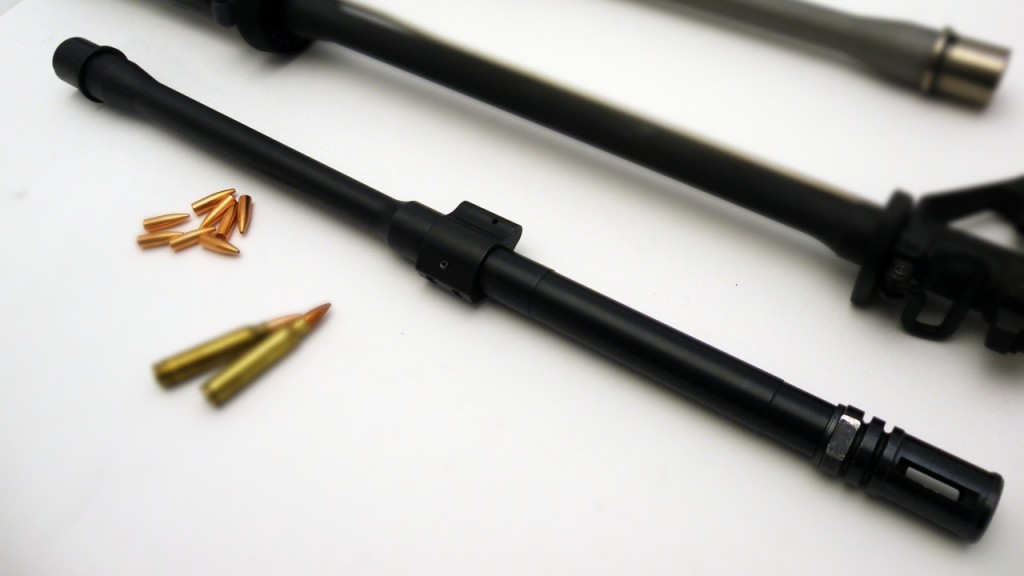
Ballistic Advantage melonited 16 inch barrel with a well loved Cav Compensator. Melonite / QPQ barrels are quickly gaining ground on the AR15 barrel market: they combines the toughness of chrome lined barrels with much of the precision of stainless steel barrels
Today we have a large choice of melonite barrels available and opinions are favorable and there has been some very positive testing done.
Truth is, this is the technology that may displace the chrome lined barrel from the market at some point… and with good reason: it has the advantages mentioned, but is also cheaper to produce vs a chrome lined, parkerized barrel. Melonited barrels will typically be a 4140 or 4150 steel, are button rifled, with a 5.56 or .223 Wylde chamber in 1/9 or 1/7 twist. So what should you look for? Again, I say go for the 4150 steel and a 1/7 or 1/8 twist, with the chamber being the shooters preference.
The reason military barrels are parkerized is due to the porosity parkerizing adds to the surface… this enhances its ability to absorb and hold oil. The melonite barrel will need no additional oil or rust preventative maintenance as the entirety of the product is dipped and covered from end to end in an extremely hard, rust resistant treatment.
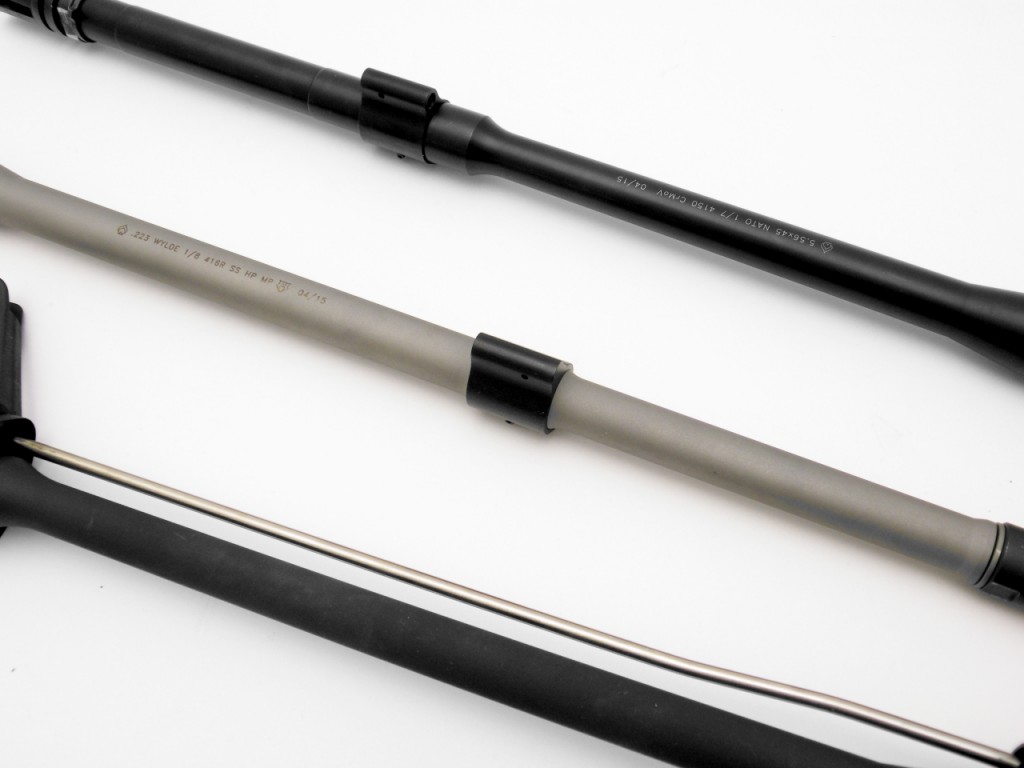
From Top: melonite, stainless steel, and a parkerized chrome lined barrel.
$ How much should I spend? Entry level melonite barrels can run $120 with more premium barrels and brands running to $240 dollars.
So hopefully you know what direction you want to take your build, and you have settled on the barrel type. The question now is, what extra features do you want in your barrel? Again let’s go back to what you want out of your rifle:
Barrel Types: Short, long, thin, thick?
Choosing the right length is a balance of weight and portability vs. velocity. This is all subjective to the needs of the individual, but there are a few general rules of thumb:
If you want a compact home defense gun, a barrel 14.5 inches or less will be adequate based on your needs. Today’s pistol builds can bring your length down even further as 10.5 is becoming quite common. As you lessen the barrel length, you increase rifle portability and decrease weight, however you gain muzzle flash, concussion, less velocity, and more recoil due to less overall weight. With common M193 or SS109 ammo, terminal performance will diminish as you decrease barrel length; however, with modern defensive ammunition, short barrels can be devastating even at lower velocities and make a good choice for shooters who don’t intend to shoot past 200-300 yards.
If you want to shoot at distances past 300 yards, consider going 14.5 inches or longer. As you increase the barrel length, you decrease rifle portability and increase weight, however you decrease muzzle flash, lessen concussion, and gain velocity. The faster you can push that bullet, the less time it will give wind and gravity the opportunity to affect it in flight. The extra velocity helps M193 and SS109 to fragment allowing you to use this very common ammo as a defensive round.
Stiffness is yet another variable. Thicker barrel profiles are stiffer than skinny profiles. Short and thick barrel profiles (such as the Colt SOCOM and 16 inch SPR profiles) are even more stiff and this will directly relate to accuracy. Stiffness suppresses a barrel’s whip (aka harmonics), and this results in more consistency shot to shot. It’s easier to find a harmonic node (“reloader” speak for a consistent point where barrel, bullet, and powder charge produce outstanding accuracy) in a stiff barrel than it is in a thin, long and skinny barrel. So you want short range accuracy? Make it short and fat.
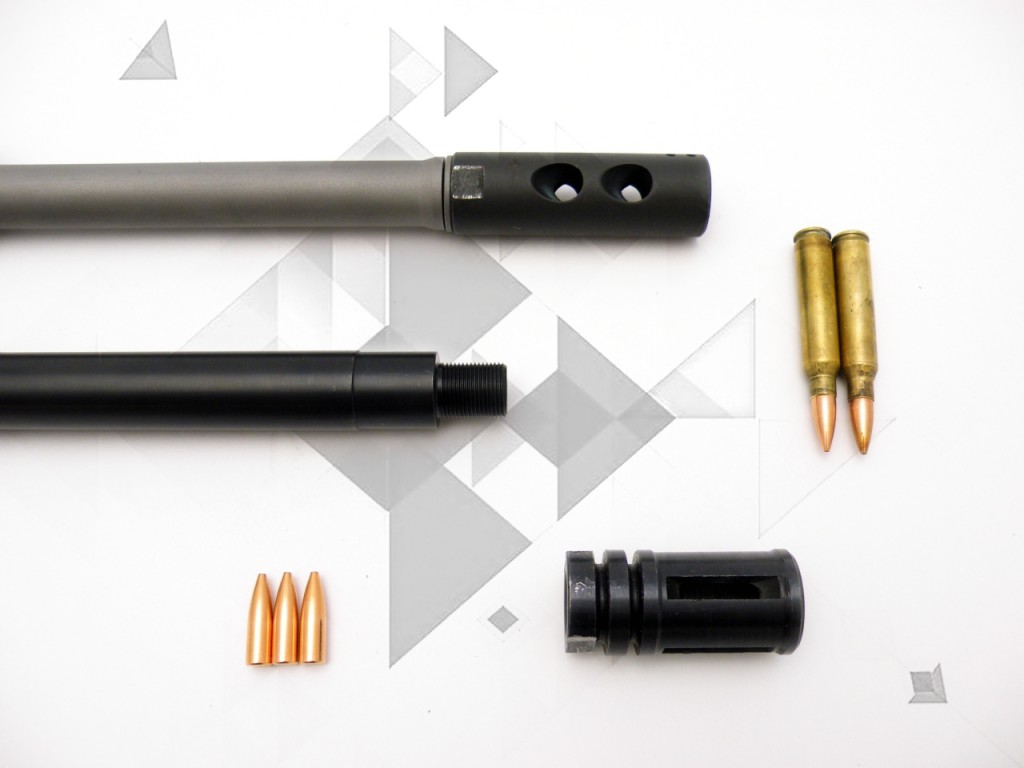
Regardless of what barrel length you choose, keep in mind that muzzle devices will add additional length to the rifle. Pictured above is a Bushmaster Y comp and below a Cav Comp.
A balance between portability and velocity would be a 14.5 to 16 inch barrel with my personal preference the 16 inch pipe. I would feel very comfortable in my home navigating the hallways and rooms with a 16 inch gun, and I would feel confident in the velocity to allow me to use M193 defensively. It also gives me enough speed that I can shoot out to 400-500 yards without a severe performance loss. Anything below 16 inches in a rifle requires NFA ATF paperwork… or a pinned flash hider to bring the length to a total of 16 inches. Sixteen inches is a great barrel length to avoid extra paperwork and to gives you a great all around “do all” barrel.
Needs are subjective, so if you want to hop out of cars and clear phone-booths, a 16 inch barrel might be too long. There are plenty of tales of shooters using very short barrels to hit targets at 500 yards plus, but take those claims with a grain of salt. While they can do it, ask them how windy it was that day. Science doesn’t lie… losing velocity increases wind drift and bullet drop, and that will matter to you if you want to practice shooting at longer distances, but the velocity loss wouldn’t matter for someone wanting a compact home defense rifle.
The Extras:
Muzzle Devices: Compensators VS Flash Hiders
Flash Hiders are designed to reduce the muzzle flash upon discharge of the rifle, and compensators (AKA Muzzle Brakes) are made to reduce recoil and lessen muzzle jump by redirecting the hot gasses produced when the rifle is discharged. There are too many products on the market to discuss them all… Ideally you will look for a device which offers a blend of flash suppression and muzzle control. I prefer these “combo style” muzzle devices which land in the middle ground of control and flash suppression: The VG6 Epsilon now graces my 16 inch carbine along with its CAGE device when I shoot at indoor ranges.
What about the A2? The A2 flash hider that comes with your barrel is a bare bones combo device which offers a hint of recoil reduction and leans more towards a flash suppressor overall. When you decide to up the ante and purchase a brake, you will notice a big difference in recoil reduction and muzzle climb will be substantially reduced. Along with a nice trigger, a quality brake will make rapid shots on target faster *and* more accurate.
M4 Feed Ramps:
Let’s keep this section short and sweet: You want a barrel which has M4 feed-ramps on the receiver extension. This has become, over the years, the de-facto industry standard. Nearly every upper receiver made today is cut for M4 feed-ramps and you want to have these ramps on the barrel receiver extension as well so everything lines up like its supposed to. It’s ok if you buy an upper receiver without the ramps… it will still work with your M4 feed-ramp equipped barrel.
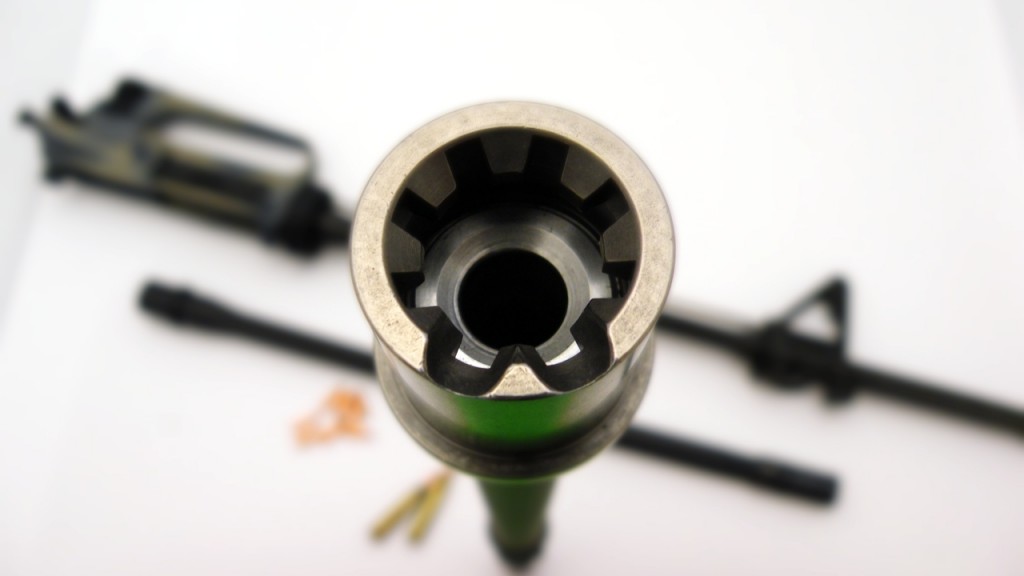
The intro pic showing off the M4 feed ramps on the Ballistic Advantage barrel.
M4 feed-ramps help ensure reliability with old, crappy magazines. As the magazine springs age, they may not push the next round to the top of the magazine feed-lips as quickly as when they were new. M4 feed ramps allow the tip of the round to strike into the receiver / barrel extension of the rifle and still ride up into the chamber. Right now, we don’t have many problems with old, crappy magazines… but that wasn’t the case during the assault weapon ban.
Wylde vs 5.56 Chambers:
.223 Wylde and 5.56 both shoot 5.56 and .223 so whats the difference? In simplified terms, .223 Wylde is a compromise between the throat angle of a .223 Saami chamber and a 5.56 chamber. Feeding 5.56 into a .223 SAAMI chamber can be a dangerous practice and could potentially cause a overpressure situation or a KaBoom! The .223 wylde relaxes the tight dimensions of the .223 SAAMI chamber and makes it safe to use with 5.56 military pressure ammunition. It also happens to allow for a bit more accuracy than a 5.56 chambered gun, and its common to see this chamber on competition rifles and accurized platforms.
Cold Hammer Forged:
Final point of discussion: CHF barrels. These barrels are created by a process where a mandrel with the reverse imprint of the rifling is pushed into the barrel blank and the cold steel is then beat by a hammer assembly to impart the rifling into the steel. You will see plenty of discussion about CHF barrels and the benefits of longer service life etc… but they command a higher price. Cold forging the steel creates a harder, more wear resistant surface, but to realize this benefit, you would need to wear away the chrome lining of a barrel before the steel starts to get eaten away. Another question we have yet to answer is how do the CHF and their superior service life stack up to melonite treated barrels? No definitive test has been conducted to determine round count vs barrel life on a CHF vs a Melonite Barrel, so we are likely to not have a clear answer here. I do have one thing to mention: Prepare to pay at least $260 – 280 dollars for a CHF barrel from a reputable manufacturer.
Whew! Thanks for reading. That was a lot of info to cover.
In Summary:
- Choose a product that will meet your shooting goals
- Choose a barrel in at least 1/8 or 1/7 twist to allow heavier bullets
- 4150 steel or 416 R stainless are good choices of barrel steel
- Choose the longest barrel that will carry out your goals
- Say no to anything chambered in .223: Go 5.56 or .223 Wylde for accuracy





